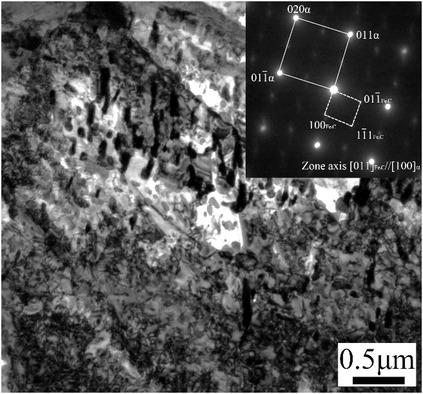当前位置:
X-MOL 学术
›
Steel Res. Int.
›
论文详情
Our official English website, www.x-mol.net, welcomes your feedback! (Note: you will need to create a separate account there.)
Thermodynamics of Phase Transformation and Microstructure Evolution of 18Cr2Ni4WA Carburized Steel during High‐Temperature Tempering
Steel Research International ( IF 2.2 ) Pub Date : 2020-05-06 , DOI: 10.1002/srin.202000094 Bin Wang 1 , Yanping He 1 , Ye Liu 1 , Yong Tian 1 , Jinglin You 2 , Raja Devesh Kumar Misra 3 , Zhaodong Wang 1 , Guodong Wang 1
Steel Research International ( IF 2.2 ) Pub Date : 2020-05-06 , DOI: 10.1002/srin.202000094 Bin Wang 1 , Yanping He 1 , Ye Liu 1 , Yong Tian 1 , Jinglin You 2 , Raja Devesh Kumar Misra 3 , Zhaodong Wang 1 , Guodong Wang 1
Affiliation

|
The microstructural evolution and phase transformation mechanism in 18Cr2Ni4WA carburized steel during high‐temperature tempering is investigated using a thermodynamic model. The experimental results demonstrate that the retained austenite in the matrix decreases from the surface to the core, and martensite transform from acicular to lath‐type. Furthermore, the hardness distribution of the carburized layer increase initially, and then decrease. Based on thermodynamic calculations, the driving forces for the decomposition of martensite decomposition and nucleation of cementite in martensite are larger than those for the decomposition of austenite during tempering. Furthermore, cementite preferentially precipitate in martensite. The driving force for the overall phase transformation of the decomposition of the retained austenite is negative, and the driving force for the nucleation of cementite in the low‐carbon retained austenite is positive, indicating that cementite can nucleate only in high‐carbon retained austenite. The low‐carbon retained austenite transform into secondary martensite on cooling after the tempering process while the driving force gradually increase. The decomposition of the initial quenched martensite during the tempering process leads to a decrease in the overall hardness of the carburized layer. The secondary martensite obtained from the retained austenite contribute to the increase in the surface hardness.
中文翻译:

18Cr2Ni4WA渗碳钢在高温回火过程中的相变和组织演变的热力学
利用热力学模型研究了18Cr2Ni4WA渗碳钢在高温回火过程中的组织演变和相变机理。实验结果表明,基体中残留的奥氏体从表面到核心逐渐减少,马氏体从针状转变为板条型。此外,渗碳层的硬度分布首先增大,然后减小。根据热力学计算,马氏体中马氏体分解和渗碳体成核的驱动力要大于回火过程中奥氏体分解的驱动力。此外,渗碳体优先在马氏体中沉淀。残余奥氏体分解的整体相变的驱动力为负,低碳残余奥氏体中渗碳体成核的驱动力为正,表明渗碳体只能在高碳残余奥氏体中成核。在回火过程中冷却后,低碳残余奥氏体转变为次级马氏体,而驱动力逐渐增加。回火过程中初始淬火马氏体的分解导致渗碳层的总硬度降低。由残留奥氏体获得的二次马氏体有助于表面硬度的增加。在回火过程中冷却后,低碳残余奥氏体转变为次级马氏体,而驱动力逐渐增加。回火过程中初始淬火马氏体的分解导致渗碳层的总硬度降低。由残留奥氏体获得的二次马氏体有助于表面硬度的增加。在回火过程中冷却后,低碳残余奥氏体转变为次级马氏体,而驱动力逐渐增加。回火过程中初始淬火马氏体的分解导致渗碳层的总硬度降低。由残留奥氏体获得的二次马氏体有助于表面硬度的增加。
更新日期:2020-05-06
中文翻译:

18Cr2Ni4WA渗碳钢在高温回火过程中的相变和组织演变的热力学
利用热力学模型研究了18Cr2Ni4WA渗碳钢在高温回火过程中的组织演变和相变机理。实验结果表明,基体中残留的奥氏体从表面到核心逐渐减少,马氏体从针状转变为板条型。此外,渗碳层的硬度分布首先增大,然后减小。根据热力学计算,马氏体中马氏体分解和渗碳体成核的驱动力要大于回火过程中奥氏体分解的驱动力。此外,渗碳体优先在马氏体中沉淀。残余奥氏体分解的整体相变的驱动力为负,低碳残余奥氏体中渗碳体成核的驱动力为正,表明渗碳体只能在高碳残余奥氏体中成核。在回火过程中冷却后,低碳残余奥氏体转变为次级马氏体,而驱动力逐渐增加。回火过程中初始淬火马氏体的分解导致渗碳层的总硬度降低。由残留奥氏体获得的二次马氏体有助于表面硬度的增加。在回火过程中冷却后,低碳残余奥氏体转变为次级马氏体,而驱动力逐渐增加。回火过程中初始淬火马氏体的分解导致渗碳层的总硬度降低。由残留奥氏体获得的二次马氏体有助于表面硬度的增加。在回火过程中冷却后,低碳残余奥氏体转变为次级马氏体,而驱动力逐渐增加。回火过程中初始淬火马氏体的分解导致渗碳层的总硬度降低。由残留奥氏体获得的二次马氏体有助于表面硬度的增加。


























 京公网安备 11010802027423号
京公网安备 11010802027423号